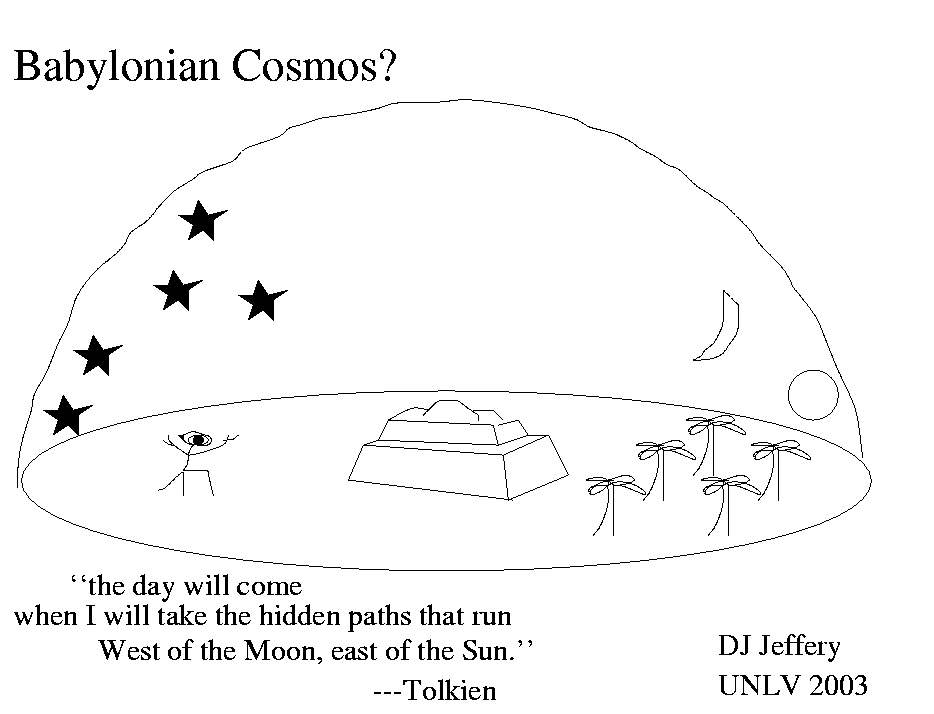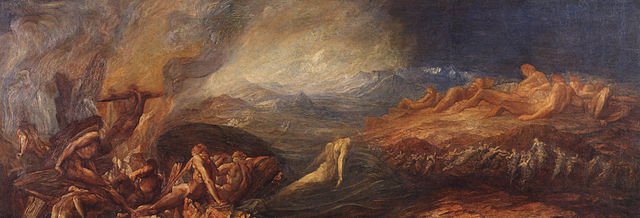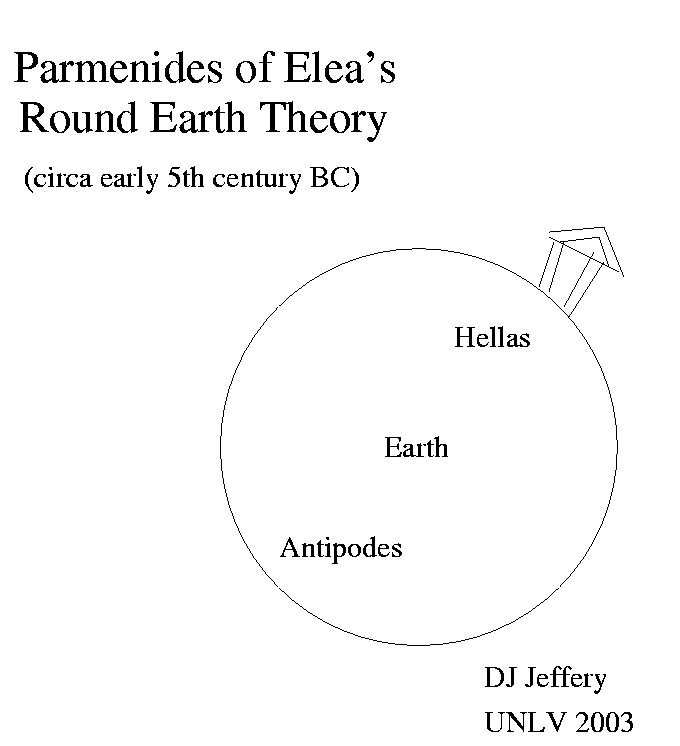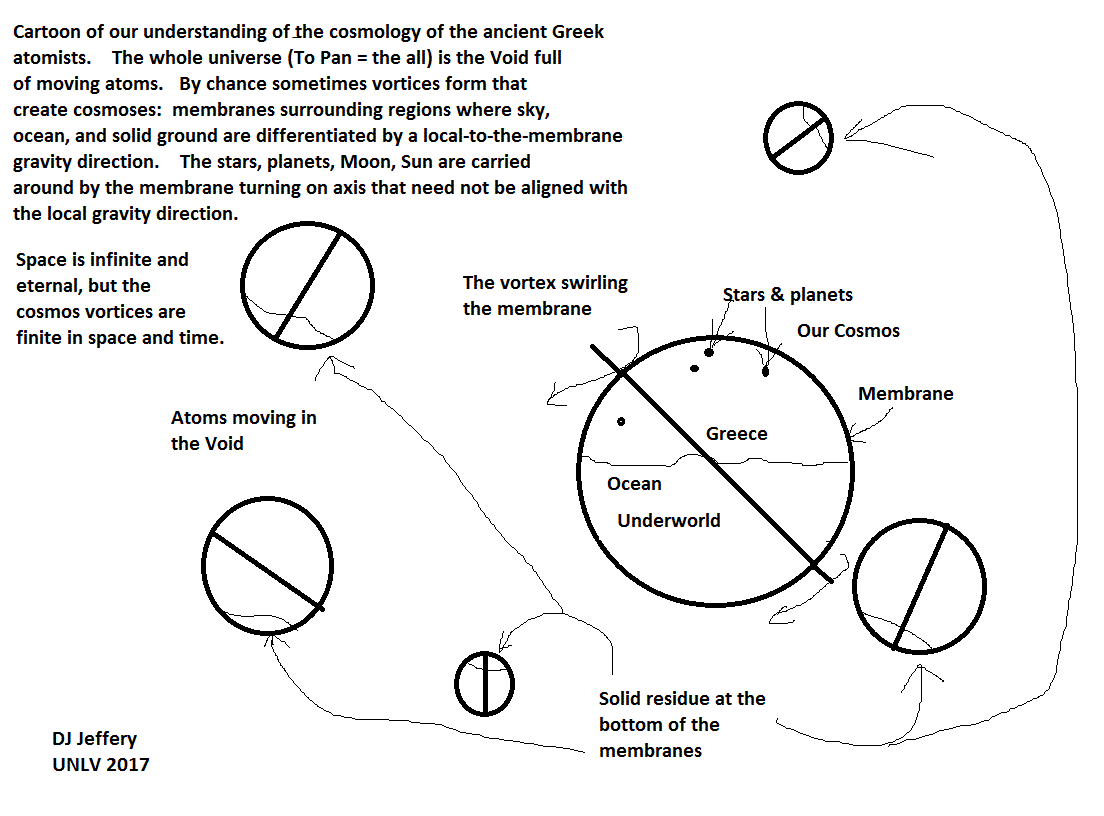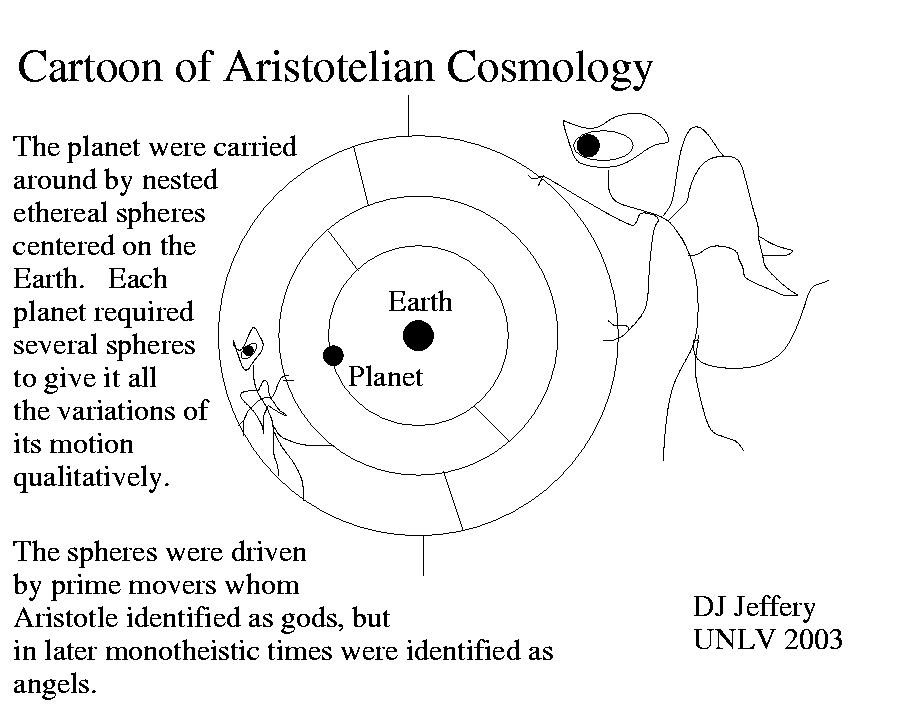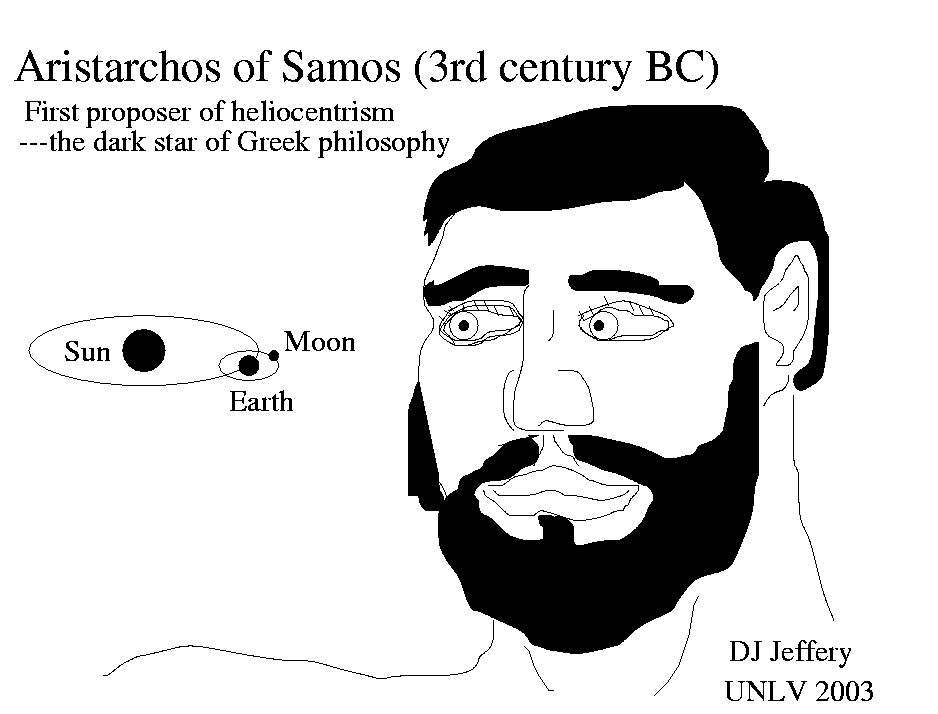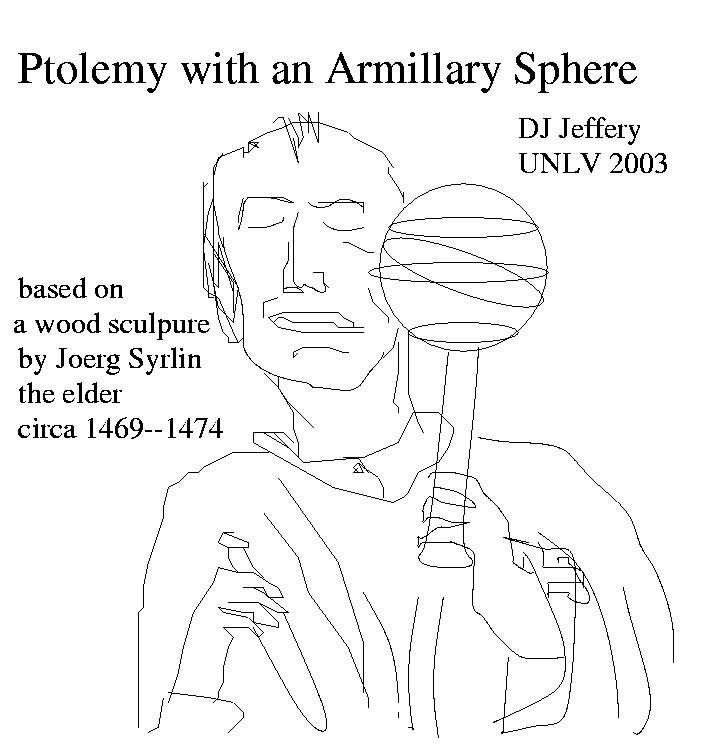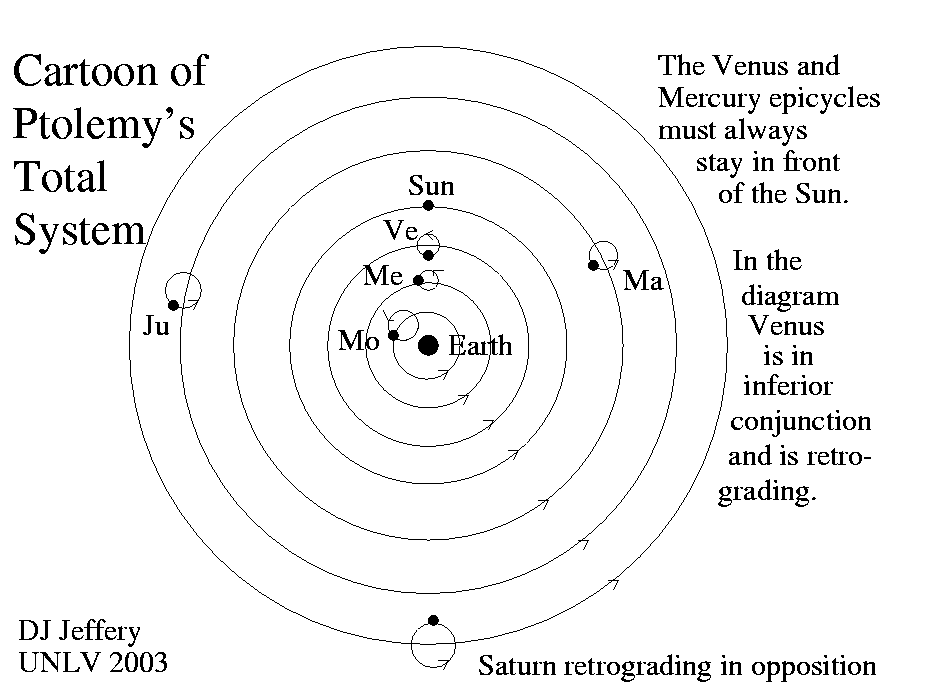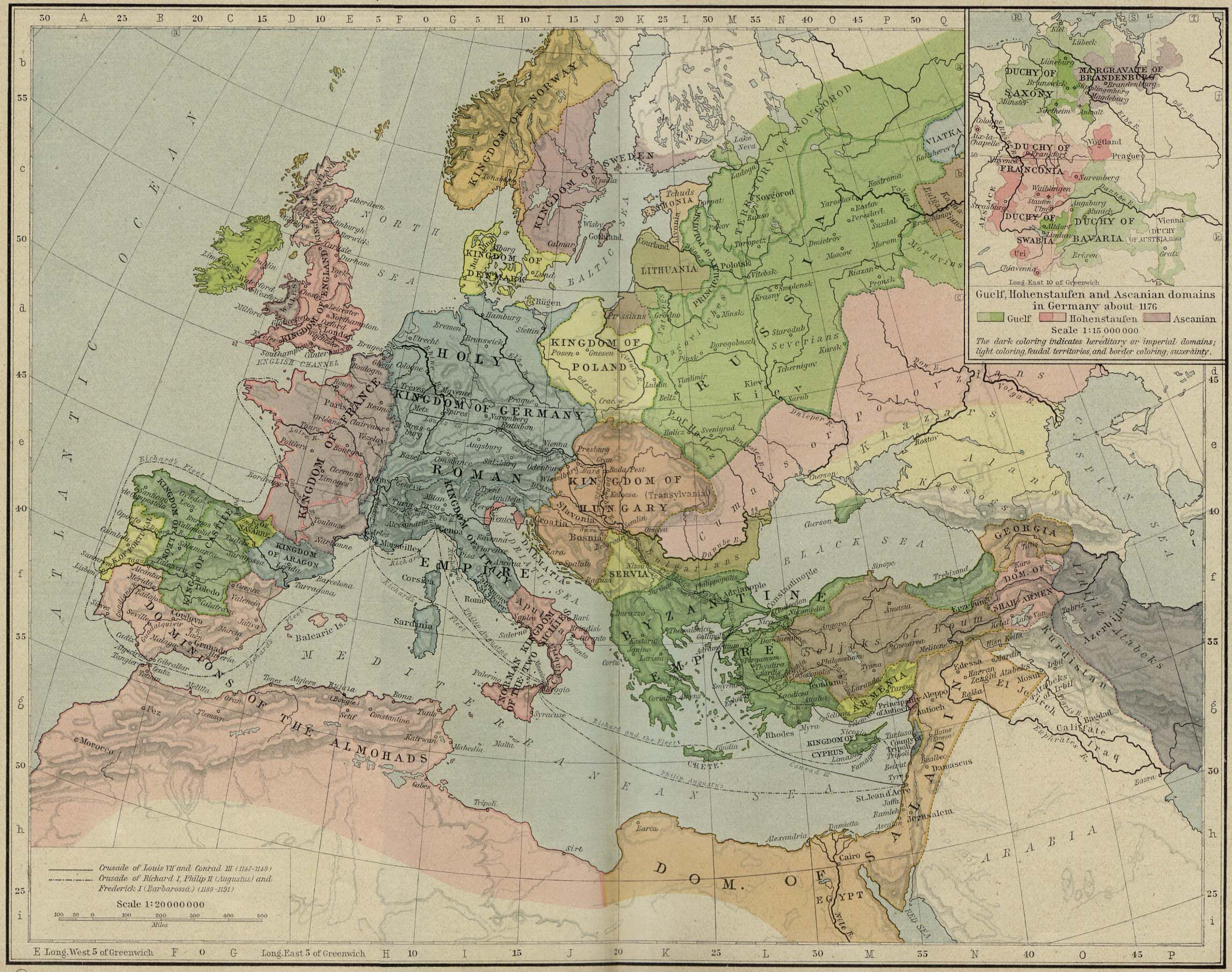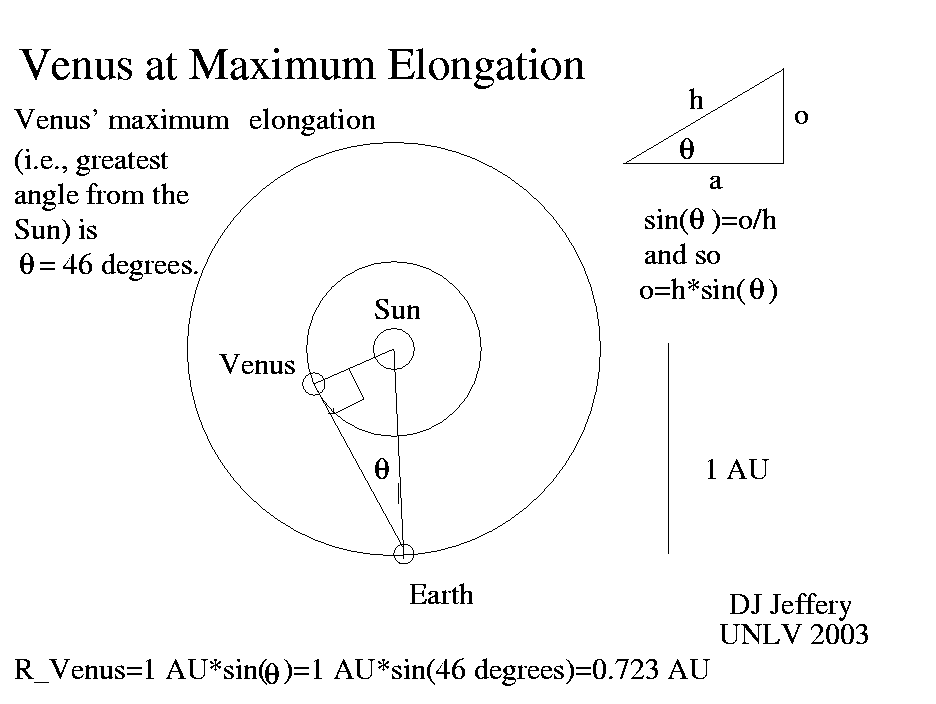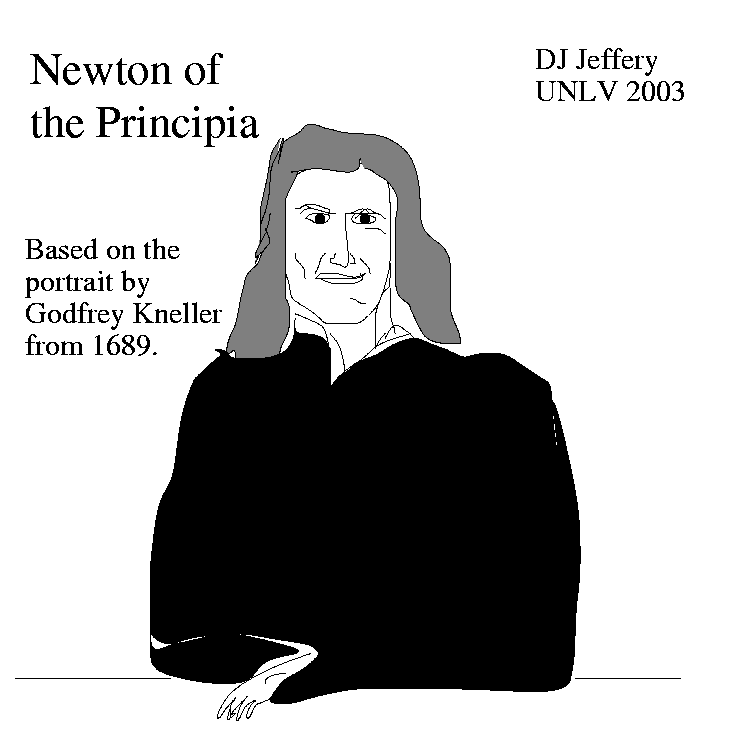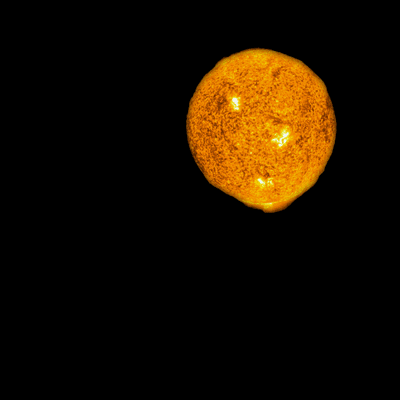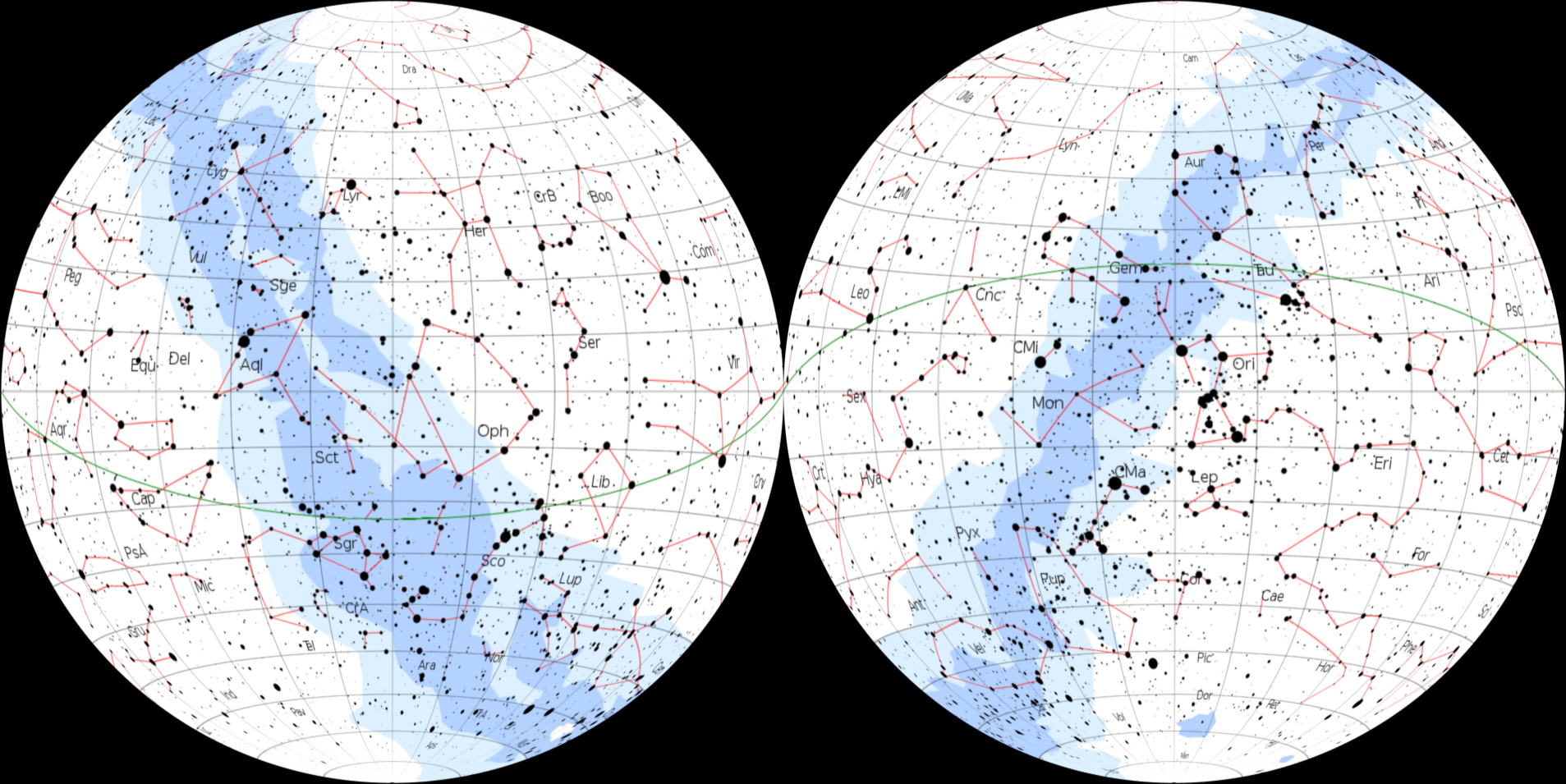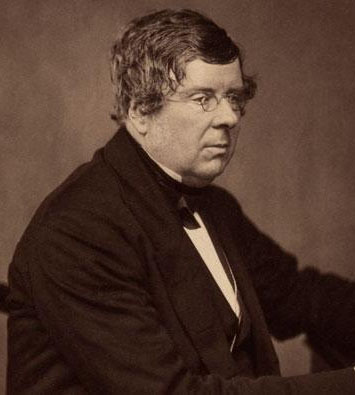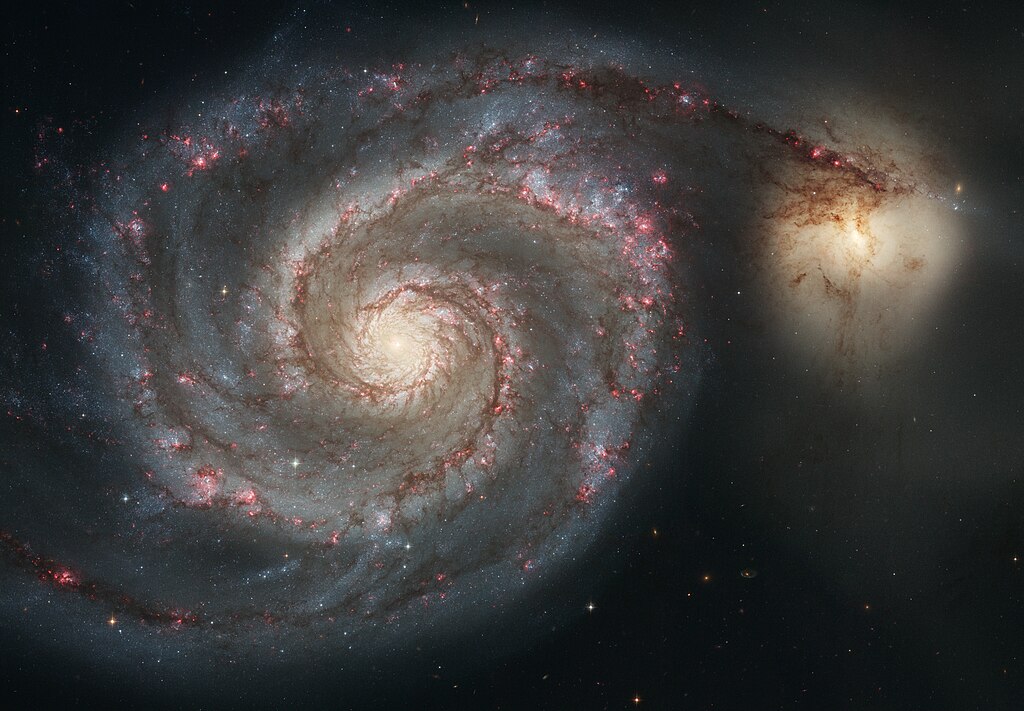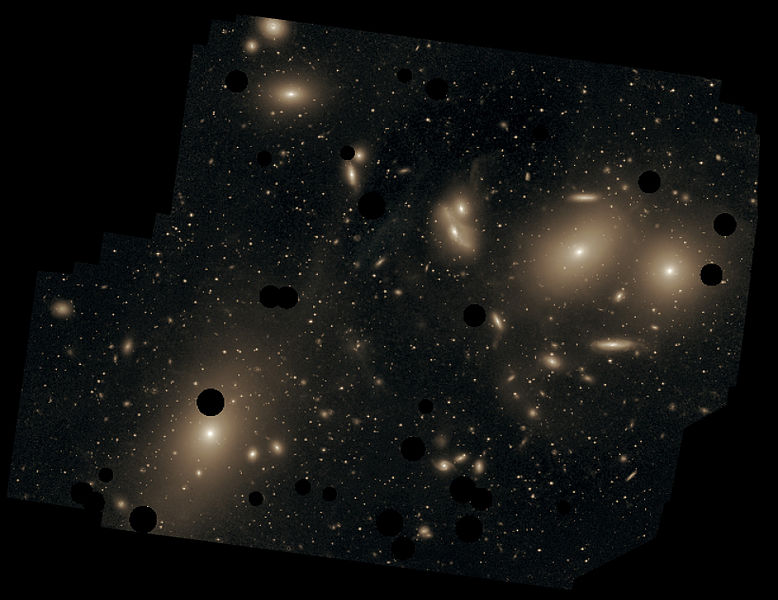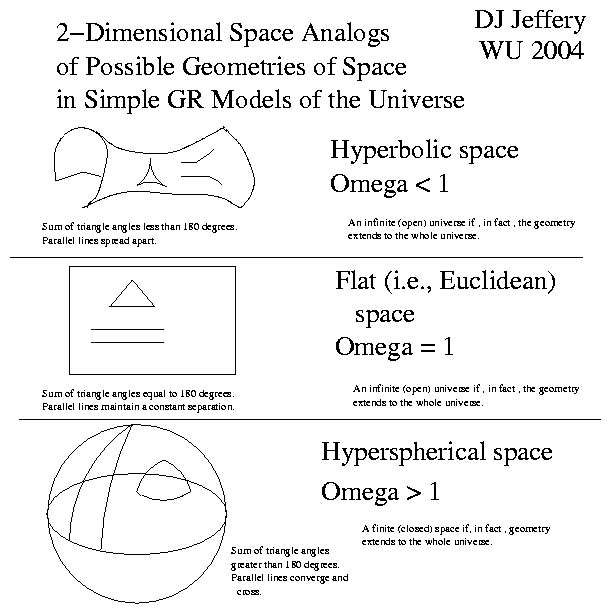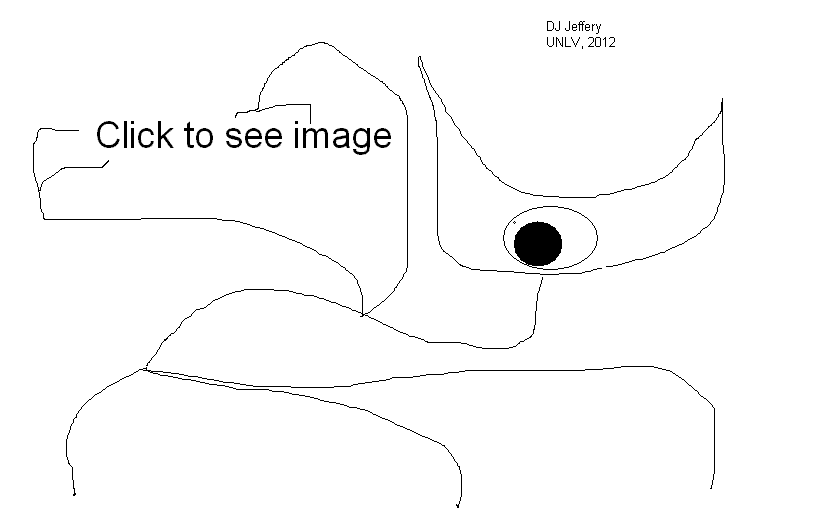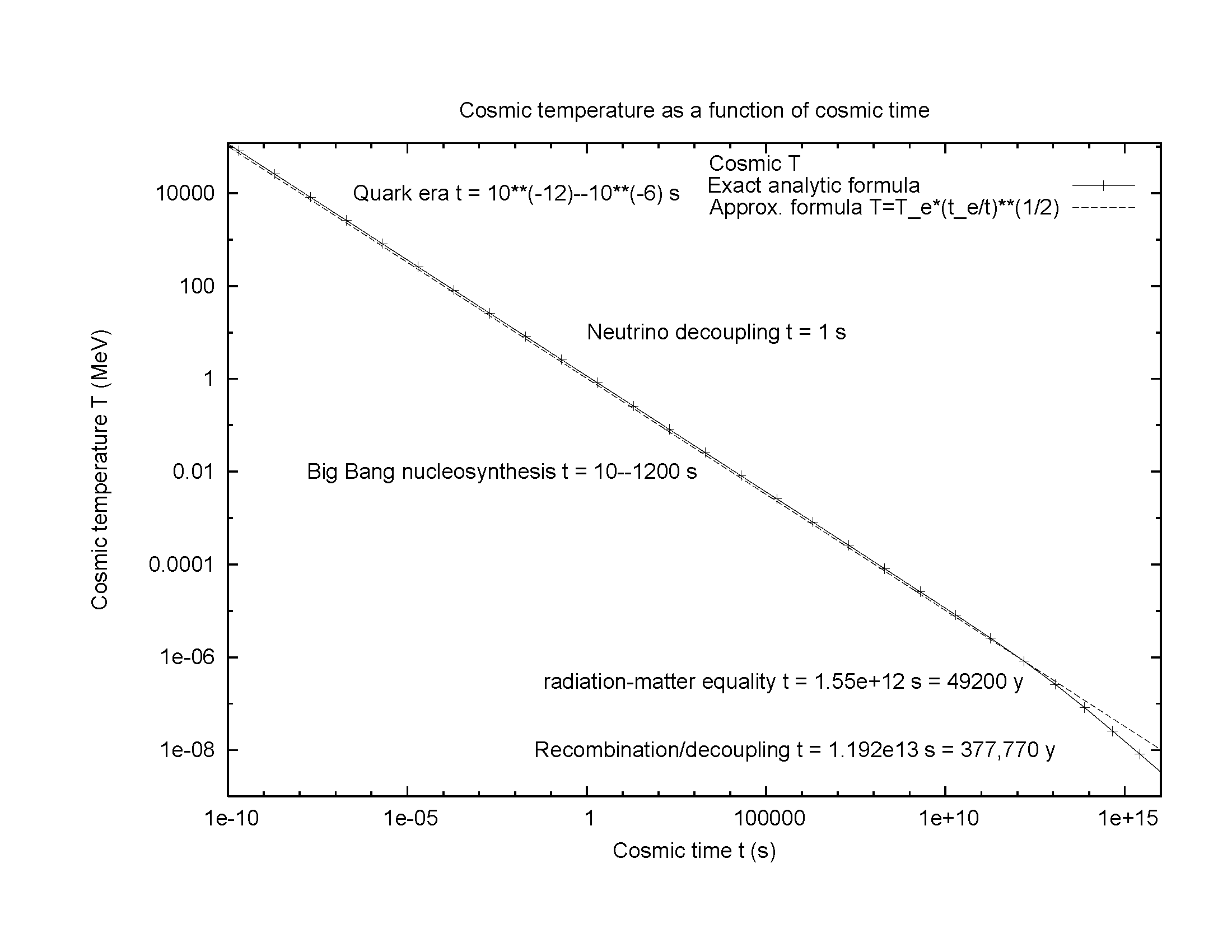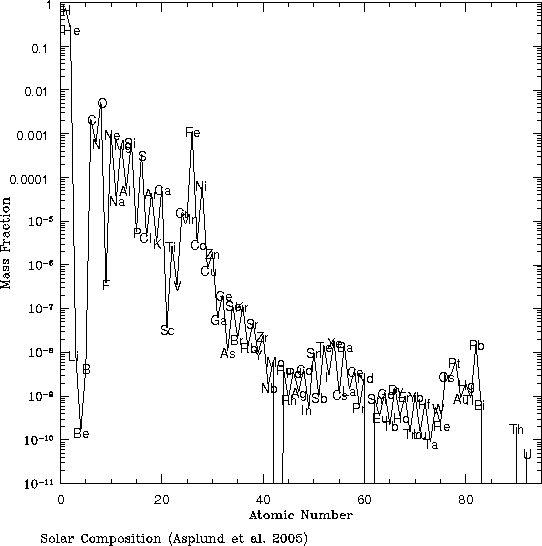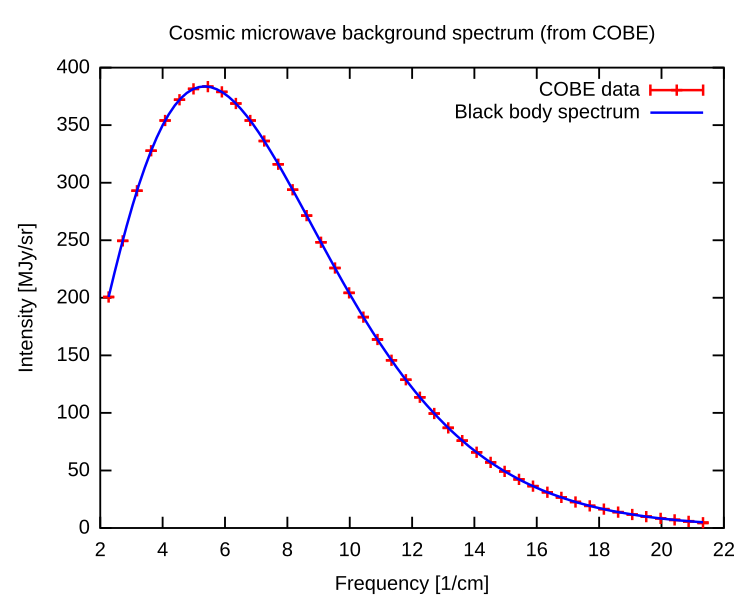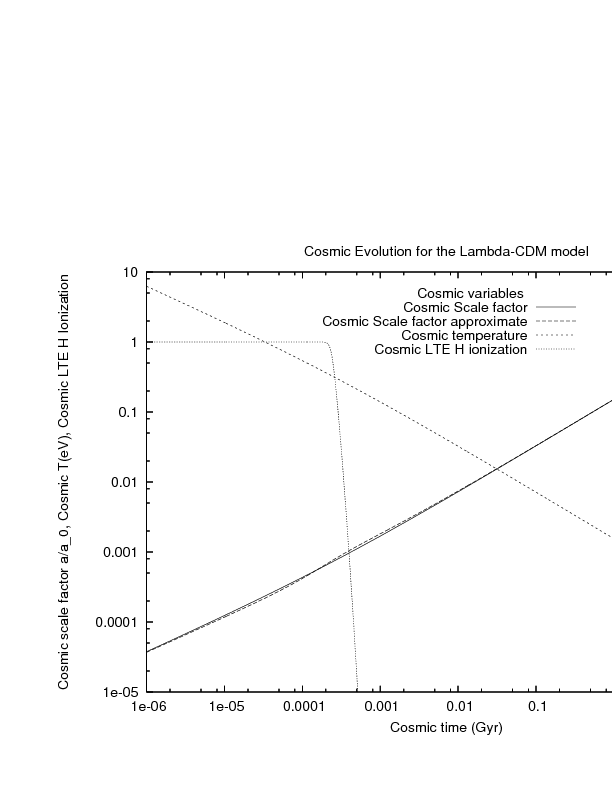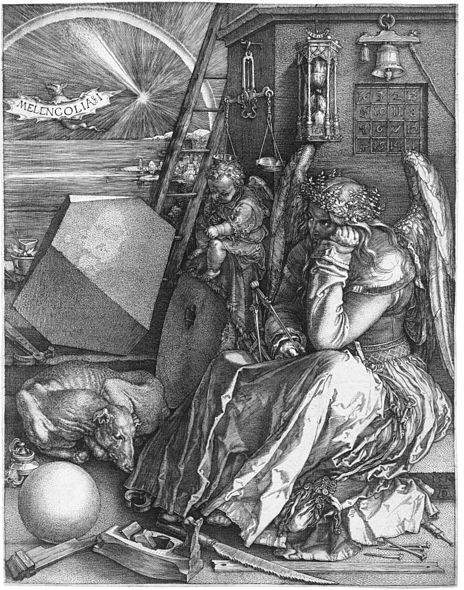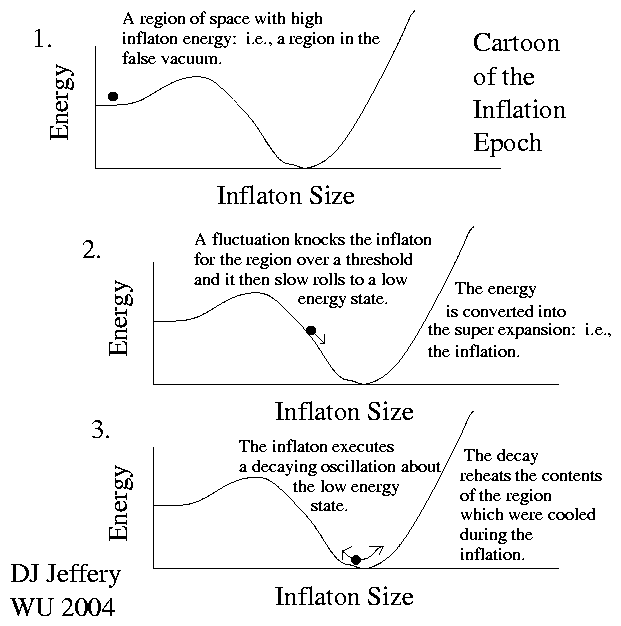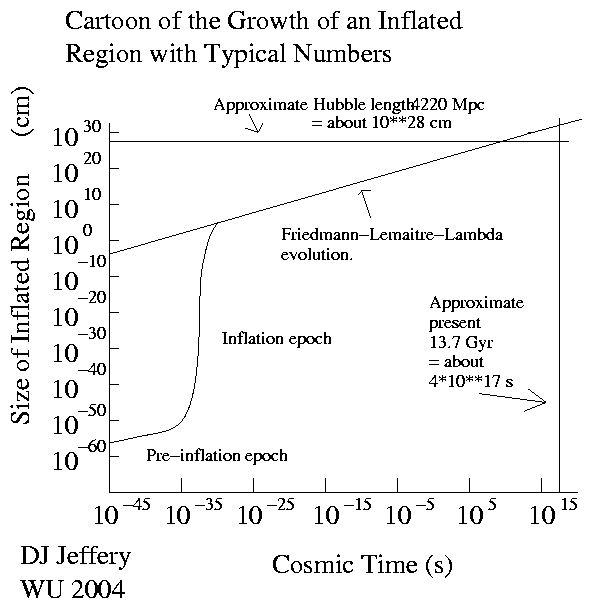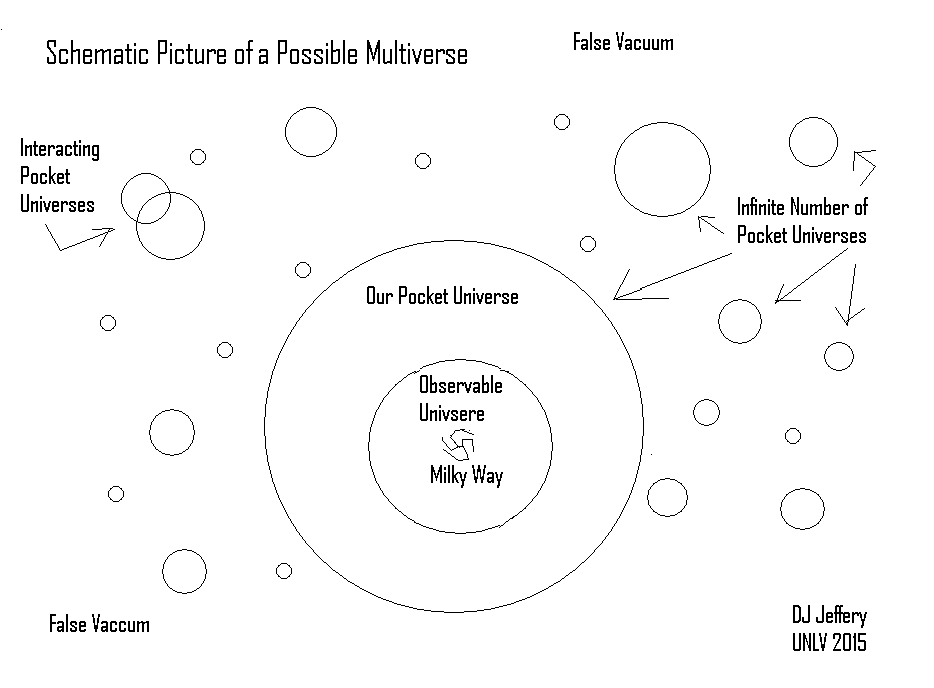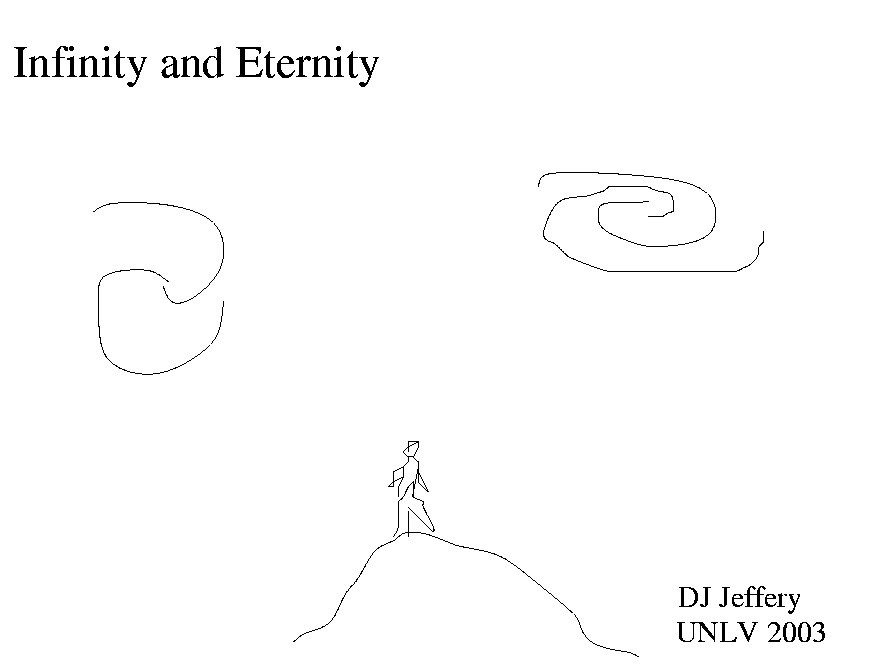-
We trace the history of cosmology
(physical cosmology, NOT
mythical cosmology)
from ancient Greek astronomy (c.700 BCE--c.400 CE)
to the present circa
2020s.
We touch on
the spherical Earth theory (c.500 BCE),
Aristotelian cosmology (c.350 BCE),
the Ptolemaic system (c.150 CE),
the Copernican heliocentric solar system (1543),
the Newtonian Universe (including absolute space,
1687--c.1920),
the discovery of galaxies,
general relativistic cosmology
(more precisely the Friedmann equation models,1917--),
the expansion of the universe (c.1920s),
Hubble's law (1929),
the primeval atom theory (c.1933),
Big Bang cosmology (1946--),
the Lambda-CDM model (c.1995--),
inflation cosmology (c.1979--),
and
multiverse cosmology (c.1980s--).
- Let's just begin.
- For the full captions for the figures and the credits, just click on the figures.
- More like forces and bodies that psychological beings in this brief cosmogony.
- So as earlier as c.700 BCE, Hesiod (fl. 700 BCE) at least briefly waxed philosophical.
 Hesiod's cosmogony
in Hesiod's Theogony (c.700 BCE):
Hesiod's cosmogony
in Hesiod's Theogony (c.700 BCE):In truth at first Chaos came to be, but next wide-bosomed Earth, the ever-sure foundation of all the deathless ones who hold the peaks of snowy Olympus, and dim Tartarus in the depth of the wide-pathed Earth, and Eros (Love), fairest among the deathless gods, who unnerves the limbs and overcomes the mind and wise counsels of all gods and all men within them. From Chaos came forth Erebus and black Night; but of Night were born Aether and Day, whom she conceived and bore from union in love with Erebus. And Earth first bore starry Heaven, equal to herself, to cover her on every side, and to be an ever-sure abiding-place for the blessed gods. And she brought forth long hills, graceful haunts of the goddess Nymphs who dwell amongst the glens of the hills. She bore also the fruitless deep with his raging swell, Pontus, without sweet union of love.
Translation: Hugh G. Evelyn-White (1874--1924). See Perseus Digital Library: Hesiod's Theogony, line 104--
- Parmenides of Elea (early 5th century BCE) may have proposed the spherical Earth theory first.
- He gave a philosophical argument, but he probably understood empirical arguments too: Earth's Earth's umbra on the Moon is always round, etc.
- According to Plato (428/427--348/347 BCE), Socrates (c.469--399 BCE) had heard of the Socrates (c.469--399 BCE) and been persuaded of it (Furley 1987, p. 55).
- Leucippus (first half of 5th century BCE) and Democritus (c.460--c.370 BCE), the atomists.
- They were flat Earthers, but posited an infinite, eternal space full of atomist atoms.
- The atomist cosmology CANNOT be fully known since only fragments of their writings remain. The cartoon below is an attempt at an explication.
- The atomist cosmology is a vague anticipation of eternal inflation.
- Aristotelian cosmology.
- Except for the spherical Earth nothing is right.
- But in western Eurasia, it had a long vogue: circa 350 BCE to circa 1600 CE.
- There were invisible nested celestial spheres on which the historical planets were carried. The outermost of these was the celestial sphere which was a solid thing on which the stars were pasted and which whipped around us once per day on the celestial axis.
- Aristotelian cosmology was qualitative. You could NOT calculate ephemerides from it.
- Aristotelians believed Aristotelian cosmology was physically correct, but only approximately. Nature was too complicated for it to be used for calculations.
- Being a bit satiric, Aristotelian cosmology is social constructivism in action---the Aristotelians agreed on it, and so it was truth.
- NOT long after Aristotle (384--322 BCE), Aristarchos of Samos (c.310--c.230 BCE) became the first person in recorded history to propose heliocentrism: historical planets (i.e., Mercury ☿, Venus ♀, Mars ♂, Jupiter ♃, Saturn ♄), NO counting the Sun ☉ and Moon ☽ orbited the Sun ☉.
- But why did Aristarchos of Samos (c.310--c.230 BCE) propose this idea? Probably for the same reasons as Nicolaus Copernicus (1473--1543) about 18 centuries later.
- Unfortunately, all we have is a few statements telling us Aristarchos of Samos (c.310--c.230 BCE) proposed heliocentrism. NO arguments for heliocentrism or detailed model of his ideas have survived.
- Nicolaus Copernicus (1473--1543) justly gets the credit for heliocentrism because he gave arguments for it that were unignorable.
-
Ptolemy (c.100--c.170 CE),
the great mathematical astronomer of
Greco-Roman Antiquity
(see also Wikipedia:
Greco-Roman World).
- A cartoon of the geocentric solar system model the Ptolemaic system of Ptolemy (c.100--c.170 CE).
- It is an epicycle model.
- Unlike Aristotelian cosmology, the Ptolemaic system was mathematical astronomy. It could be used to calculate ephemerides.
- About the ordering of the
historical planets
(i.e., the Moon ☽,
Mercury ☿,
Venus ♀,
Sun ☉,
Mars ♂,
Jupiter ♃,
Saturn ♄),
Ptolemy (c.100--c.170 CE) argued if
the outer historical planets
moved at the same speed in space
then if they move slower in the
sky, then they are farther away.
a reasonable argument and it gives correct answers insofar as they can be correct in the incorrect geocentric solar system model. - But no one knew how far the historical planets were or their ordering.
- Except the ancient Greek astronomers knew the Moon was ∼ 60 Earth radii away from the Earth.
- A key point about epicycle models is they are vastly non-unique. You can make many versions and they will all give you approximately the same ephemerides. For ∼ 13 centuries in western Eurasia, people tried all kinds of versions.
- The non-uniqueness problem suggested epicycle models were just NOT true and strict Aristotelians argued this.
- Aristotelian cosmology which Aristotelians argued was essentially physically real, but qualitative and so could NOT be used calculate ephemerides because nature was too complex.
- Ptolemaic system which could be used to calculate ephemerides, but according to Aristotelians was just a calculating tool---which is true.
-
Now Ptolemy (c.100--c.170 CE) mostly
followed
Aristotelian physics
in many respects, but the
Ptolemaic system
is NOT consistent
with Aristotelian cosmology,
and so western Eurasia
was stuck with two geocentric solar system models:
- the spherical Earth.
- atomism and the infinite universe, but as a minority view.
- the heliocentric solar system, but as very minority view.
- mathematical astronomy.
-
The ancient Greek astronomers
had many of the ingredients for great advances in
astronomy
and cosmology:
But the ancient Greek astronomers did NOT put the pieces together and neither did the Medieval astronomers.
-
But many advances were made in the
Middle Ages in
western Eurasia:
But in theoretical astronomy, western Eurasia was stuck in the mire of the double astronomy of Aristotelian cosmology (see Aristotelian cosmology cartoon) and the Ptolemaic system (see Ptolemaic system cartoon).
- Nicolaus Copernicus (1473--1543):
maybe a self-portrait
or based on one.
- One diagram shows you why
Nicolaus Copernicus (1473--1543)
posited
heliocentric solar system.
- Nicolaus Copernicus's (1473--1543) own
Copernican system
not-to-scale.
- Thomas Digges' (c.1546--1595)
and the return of the
infinite (or quasi-infinite) universe:
- After Thomas Digges (c.1546--1595), the development of the Copernican system is really history of the knowledge of Solar System, NOT cosmology per se.
- So yours truly will NOT detail the history of Copernican Revolution: Tycho Brahe (1546--1601), Galileo (1564--1642), Johannes Kepler (1571--1630), etc.
- Newtonian physics
explicated the Solar System
and in
the thinking of Isaac Newton (1643--1727)
and most of his contemporaries
the Solar System
was embedded in a universe
of stars which probably had their
own planetary systems.
Isaac Newton (1643--1727) only speculated a little and inconclusively on the structure of the universe and what held it up against self-gravity.
- Isaac Newton (1643--1727) presented
in his book the
Principia (1687):
Newton's 3 laws of motion,
Newton's law of universal gravitation,
etc.
By the way, the Principia (1687) is an awful book.
- But there was a problem
with a universe
of stars:
Olbers' paradox
which was known long before
Heinrich Wilhelm Matthias Olbers
(1758--1840)
and was explicated by none other than
Edmond Halley (1656--1742)
directly to Newton himself
at a meeting of the
Royal Society.
Olbers' paradox is strong evidence against an infinite, eternal, static universe full of stars.
- The universe
of stars, full or NOT, had another aspect:
- The stars were NOT spread uniformly throughout space, infinite or NOT. They were somewhat concentrated into the Milky Way
- 18th century speculators posited that the Milky Way was disk of stars held up by rotation around a center of mass and the Sun was embedded in this disk. This is, of course, absolutely correct.
- Below is an all-sky sky map showing the Milky Way which you CANNOT see in Las Vegas, Nevada because of all the light pollution---recently added to by the Las Vegas Sphere (formally Sphere at The Venetian Resort)---which can be used as a giant celestial globe, so who needs the night sky. Yours truly wishes he had a button that could turn off the Las Vegas Strip for an hour or so during lab time.
- William Herschel (1738--1822):
- William Herschel (1738--1822)
followed up the idea of the
Milky Way as a disk by
mapping it with star gages.
It was a great idea, but he was defeated by interstellar dust.
- William Herschel (1738--1822) is famous
for discovering
Georgium Sidus which
we call Uranus ⛢,♅.
And he was a composer: William Herschel (1738-1822) - Symphony No 12 in D Major, 2nd movement 4:26--11:30.
- William Herschel's (1738--1822)
map is below which is a
cross section
of the Milky Way, or so
yours truly guesses.

- William Herschel (1738--1822)
followed up the idea of the
Milky Way as a disk by
mapping it with star gages.
-
How did we discover there were other
galaxies other than
the Galaxy (AKA Milky Way)?
- In recorded history,
knowledge of the
nebulae (historical usage)
goes back to
Ptolemy (c.100--c.170 CE).
- But, of course,
Ptolemy (c.100--c.170 CE)
did NOT know of the most prominent
nebulae (historical usage)
the Magellanic Clouds
(i.e., Large Magellanic Cloud (LMC) and
Small Magellanic Cloud (SMC)).
- That the
nebulae (historical usage)
as other galaxies was guessed at fairly early
in the post Copernican Revolution era
by none other than Sir Christopher Wren (1632--1723)
more famous as an architect,
than as an astronomer:
-
Sir Christopher Wren
Said, "I am going to dine with some men.
If anyone calls
Say I am designing St. Paul's.
-
----a clerihew by
Edmund Clerihew Bentley (1875--1956).
Sir Christopher Wren's (1632--1723) speculation:
-
... a Time would come, when
Men should be able to stretch out their
Eyes
as Snails
do, & extend them to fifty feet
in length; by which means, they
should be able to discover Two thousand Times as many
Stars as we can;
and find the Galaxy (i.e., Milky Way)
to be Myriads of them; and every
nebulous Star
appearing
as if it were the
Firmanment
of some other World,
at an incomprehensible Distance,
bury'd in the vast Abyss of intermundious Vacuum ...
Sir Christopher Wren's (1632--1723) speculation had NO historical impact, but shows even before Newtonian physics that at least someone could speculate on a universe full of galaxies in addition to one full of stars.
Others in the 18th century speculated on other galaxies: the architect Thomas Wright (1711--1786), the philosopher Immanuel Kant (1724--1804), and the mathematician Heinrich Lambert (1728--1777). William Herschel (1738--1822) was aware of these speculations, but yours truly CANNOT find any reference to say what he thought of them, but he probably suspended judgment.
- In the 19th century, we come to
Lord Rosse (1800-1867)---who
may have believed in other galaxies.
- Lord Rosse (1800-1867)
built the largest telescope up to
his time the
Leviathan of Parsonstown (1.83 m = 6 ft,
operational 1845--c.1890).
- The discovery of the
spiral nebulae (i.e., that
some nebulae (historical usage)
had spiral structure) by
Lord Rosse (1800-1867)
using the
Leviathan of Parsonstown (1.83 m = 6 ft,
operational 1845--c.1890).
Below is Lord Rosse's (1800-1867) drawing from visual astronomy of the Whirlpool Galaxy (AKA M51a/NGC 5194 and M51b/NGC 5195) in constellation Canes Venatici in 1845.
- Below is a modern image of
Whirlpool Galaxy (AKA M51a/NGC 5194 and M51b/NGC 5195).
Qualitatively, Lord Rosse (1800-1867) didn't do too badly.
- Edwin Hubble (1889--1953)
discovered in 1924
(see Wikipedia:
Edwin Hubble: Universe goes beyond the Milky Way galaxy)
that the spiral nebulae
were other galaxies,
and so, of course, were the
elliptical nebulae
since they were found in
galaxy clusters
with spiral nebulae.
- Hubble tuning fork diagram
which
Edwin Hubble (1889--1953)
invented in 1926
shortly after discovering the extragalactic nature of the
nebulae (historical usage).
It classifies spiral galaxies, elliptical galaxies, lenticular (S0) galaxies, and irregular galaxies.
- Edwin Hubble's (1889--1953) discoveries were predicated on having the best telescope in the world in the 1920s when southern California was a great observing site.
- Edwin Hubble's (1889--1953) discovery
was made by determining the distance to the
Andromeda Galaxy (M31, NGC 224)
using Cepheid variables:
- He reported in 1924,
Hubble had established the
distance to the
Andromeda Galaxy (M31, NGC 224)
to be 285 kpc
(No-510).
- This is NOT a very accurate result.
Hubble had various
systematic errors
in his measurements and calibrations that are entirely understandable given his time.
- The modern distance to the
Andromeda galaxy
is about 725 kpc (Cox-578): this
∼ 2.5 times
Edwin Hubble's (1889--1953) value.
- But even if
Hubble's contemporaries
suspected large errors---and they may have---they did concede??? that
the Andromeda galaxy
had to be a remote large system of stars comparable
in size to Milky Way.
It's ironic to think that an extremely important true result was accepted as such while unknown large systematic errors weakened original evidence on which it was accepted.
- The observable universe
was a universe
of galaxies.
Edwin Hubble's (1889--1953) entitled
his famous book The Realm of the Nebulae
(Edwin Hubble, 1936, Google Books, partially online)
(see also The Realm of the Nebulae (Edwin Hubble, 1936,
NASA/ADS);
No-509).
- Edwin Hubble's (1889--1953) remained old-fashioned
in that he continued to call
galaxies
nebulae (historical usage).
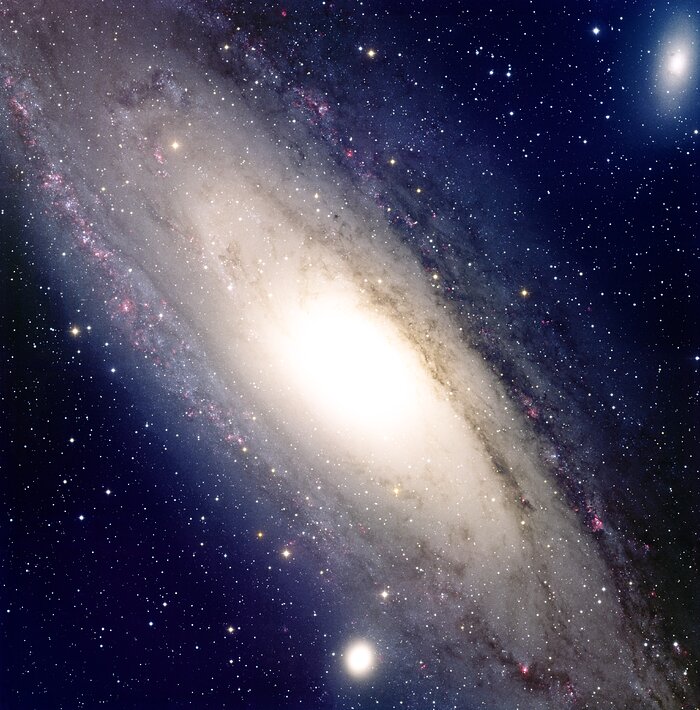
- He reported in 1924,
Hubble had established the
distance to the
Andromeda Galaxy (M31, NGC 224)
to be 285 kpc
(No-510).
- The Virgo Cluster where
spiral galaxies
and elliptical galaxies
are found together which proved that
if spiral nebulae were
galaxies that
elliptical nebulae were
also galaxies.
- Albert Einstein (1879--1955) in his prime.
- The Einstein universe (1917):
finite, unbounded cosmological model
with the geometry
of the surface of
4-dimensional
Euclidean space
sphere:
i.e., a 3-N hypersphere.
- EOF
- cosmological constant Λ
is an extra term in the
Einstein field equations
that only has an effect on the
cosmological scale, and so does not affect any
of the other results of
general relativity.
- By klutzy means, we mean
Albert Einstein (1879--1955) did NOT
have the Friedmann equation (FE, 1922).
If he had discovered the
Friedmann equation (FE, 1922) himself,
his work in cosmology would have been
vastly easier.
Einstein universe (1917) is, in fact, a Friedmann-equation (FE) model discovered without using the Friedmann equation (FE, 1922).
- Albert Einstein (1879--1955)
adjusted the
cosmological constant Λ
to make the Einstein universe (1917) static.
- In fact,
Albert Einstein (1879--1955) was NOT
trying to create a cosmological model
of full realism which he new was far too ambitious for 1917.
- What he was trying to do was show that
a cosmological model
consistent with general relativity could be found.
- General relativity
was posited as a univeral theory.
For this to be true, general relativity had to apply to the universe as whole.
Newtonian physics does NOT do this without extra hypotheses.
- Of course,
Albert Einstein (1879--1955) thought he
needed one extra hypothesis too:
the cosmological constant Λ.
- In fact, he did NOT need it as
Alexander Friedmann (1888--1925) would show---if
you allow for expanding universe
or a contracting universe.
- cosmological constant Λ
is an extra term in the
Einstein field equations
that only has an effect on the
cosmological scale, and so does not affect any
of the other results of
general relativity.
- Willem de Sitter (1872--1934),
de Sitter universe (1917),
and the cosmic scale factor a(t).
- Willem de Sitter (1872--1934)
discovered de Sitter universe (1917)
also in 1917 which is also,
in fact, a
Friedmann-equation (FE) model discovered
without using the Friedmann equation (FE, 1922).
- The de Sitter universe (1917)
is an
exponentially expanding
Friedmann-equation (FE) model
with NO matter
and NO
electromagnetic radiation (EMR).
It just has the cosmological constant Λ.
It is also infinite and eternal---it's been expanding emptily forever and always will.
But the de Sitter universe (1917) did predict the expanding universe and the cosmological redshift.
It also predicted Hubble's law, but no one seems to have noticed that explicitly.
- What is the expanding universe
in Friedmann-equation (FE) models?
In the ideal, Friedmann equation (FE) model, all lengths scale with cosmic time by the cosmic scale factor a(t):
r(t) = a(t)*r_0
where 0 symbolizes cosmic present = to the age of the observable universe = 13.797(23) Gyr (Planck 2018).
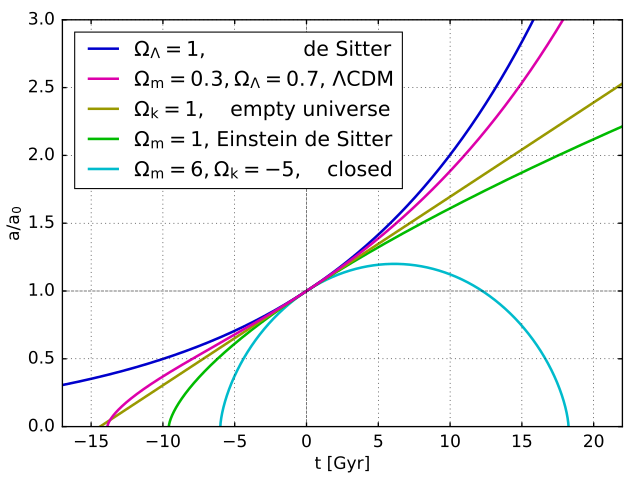
- Willem de Sitter (1872--1934)
discovered de Sitter universe (1917)
also in 1917 which is also,
in fact, a
Friedmann-equation (FE) model discovered
without using the Friedmann equation (FE, 1922).
- Alexander Friedmann (1888--1925)
and the
Friedmann equation (1922).
The Einstein universe (1917) and de Sitter universe (1917) are Friedmann equation (FE) models discovered by klutzy means before the discovery of the Friedmann equation (1922).
What is the Friedmann equation (1922)?
The Friedmann equation (1922) describes the dynamics of the universe as whole.
- It is derived from general relativity. with simplifying assumptions about what the universe.
- The universe is homogeous and isotropic.
- The universe has no boundary in space though it may have in time.
- All matter, electromagnetic radiation (EMR), or any other mass-energy can be modeled as perfect fluids.
- The independent variable is time.
- The dependent variable is the cosmic scale factor a(t).
- The Friedmann equation (1922) is an ordinary differential equation. But it is nonlinear differential equation with only a limited set of analytic solutions.
- The Einstein universe (1917) is the only static solution to the Friedmann equation (1922): all other solutions are expanding or contracting.
- Alexander Friedmann (1888--1925) used the Friedmann equation (1922) find some Friedmann equation (FE) models: i.e., cosmic scale factor a(t).
- Unfortunately,
Alexander Friedmann (1888--1925)
published in Russian
no one much outside of Russia knew
about his work until several years later by which time he had passed away.
Except none other than
Albert Einstein (1879--1955) knew about
Friedmann's work, but he
took NO interest it until the early 1930s.

- Georges Lemaitre (1894--1966)
between
Robert Millikan (1868--1953)
and Albert Einstein (1879--1955)
at Caltech,
1933
Jan10.
Lemaitre independently discovered the Friedmann equation (1922) in 1927. None other than Albert Einstein (1879--1955) informed him that it was a rediscovery in 1927 (see MacTutor: Georges Lemaitre (1894--1966)).
However, Lemaitre explicitly discovered (as Alexander Friedmann (1888--1925) did NOT) Hubble's law as a necessary consequence of the Friedmann equation (1922).
This was a theoretical discovery of a consequence of the Friedmann equation (1922), NOT an empirical discovery that the observable universe obeyed Hubble's law.
However, Georges Lemaitre (1894--1966) did deduce a value for the Hubble constant based on published data that was only somewhat worse than Edwin Hubble (1889--1953) own value from 1929.
But this was NOT a proof that Hubble's law applied to the observable universe.
No one much noticed Georges Lemaitre (1894--1966) work in 1927. This was strange since Lemaitre was actually well known to people interested in cosmology then---maybe 10 of them. He did publish in French and the obscure Annals of the Scientific Society of Brussels. He probably should have advertized his work a bit more.
One person who did notice was again Albert Einstein (1879--1955)---who didn't think much of it at that time.
- Hubble's law was empirically discovered
by Edwin Hubble (1889--1953)
in 1929.
v=Hr
which holds for every instant in cosmic time in Friedmann equation (FE) models.Hubble's value for the Hubble constant was really bad: i.e., ∼ 500 (km/s)/Mpc.
This suggested a characteristic age for the observable universe of order 2 billion years.
But circa 1930, the Earth was already known to be of order 3 billion years from radioactive dating.
So there was an AGE PROBLEM which was only finally resolved when the Hubble constant was revised to 50--100 500 (km/s)/Mpc after circa 1950.
- Now most Friedmann equation (FE) models
imply a point origin for the
observable universe
which we now call Big Bang singularity.
In the 1930s, most cosmologists---of whom there were maybe 10---thought nothing of this.
But Georges Lemaitre (1894--1966) presented his primeval atom origin in 1931--1933 which is a "cold big bang theory" as a part of what we can call the the Lemaitre universe (1933)---an ingenious theory that turned out to be wrong---and probably did NOT excite as much interest as it should have had in the 1930s.
- In the earliest time traceable (but NOT the beginning of time), the universe was a giant "neutron star" (i.e., the primeval atom itself) that filled a finite, unbounded 3-N hypersphere. So an actual point origin was avoided.
- It was expanding and decelerating initially.
- The primeval atom fragmented into smaller atoms by radioactive decay: "nuclear fission", but NOT our nuclear fission which was discovered in (see Wikipedia: Nuclear fission: Discovery of nuclear fission; Wikipedia: Discovery of nuclear fission).
- There was a nearly zero growth phase (Einstein universe (1917) phase) which could be as long as needed by adjusting the cosmological constant Λ. This avoided the AGE PROBLEM of the 1930s.
- In the Einstein universe (1917) phase, gravitational collapses occurred leading to galaxies and stars which were powered by radioactive decays.
- After the Einstein universe (1917) phase, the universe began to exponentially expand and became the expanding universe we observe.
- The expanding universe is in a de Sitter universe (1917) phase.
- (Lost Media) Interview with Georges Lemaitre (1964)| 19:47: Georges Lemaitre (1894--1966), the Master (it's his name), speaks to us from across the centuries---prospectively speaking. And with Flemish subtitles.
- George Gamow (1904-1968) proposed
and the Big Bang theory
(a "hot big bang")
in its earliest form in 1946
(see Wikipedia: Big Bang:
Concept history;
Wikipedia: History of the
Big Bang theory;
Gamow, G. 1946, Physical Review,
572--573, Expanding Universe and the Origin of the Elements).
George Gamow (1904-1968) and his colleages Ralph Alpher (1921--2007) and Robert Hermann (1914--1997) (who knew a lot more about nuclear physics than the other George---Georges Lemaitre (1894--1966) proposed for near the mythical point origin:
- A hot phase rich in photons with
a relatively small amount of
mass-energy
in the form of matter.
- He proposed that
ALL the elements of the
observable universe were synthesized in
this hot early phase of expanding universe
by nuclear fusion.
This is what came to be called
the Big Bang.
- The expansion of the universe caused adiabatic cooling and turned off the Big Bang nucleosynthesis era (cosmic time ∼ 10--1200 s ≅ 0.17--20 m in modern theory).
- Gravitational collapses
occurred leading to
galaxies and
stars which were powered
by nuclear fusion.
- The cosmic background radiation (CBR)
left over from the
Big Bang also
adiabatic cooled
and became the
modern
cosmic microwave background (CMB).
- Ralph Alpher (1921--2007)
and Robert Hermann (1914--1997)
predicted the
cosmic microwave background (CMB)
and predicted its temperature
would be ∼ 5 K.
Their predicted temperature
is fortuitously close to the
modern value
CMB temperature T=2.72548(57) K.
Their calculation was actually NOT right
(see Mike Turner 2021, Predicting the CMB temperature).
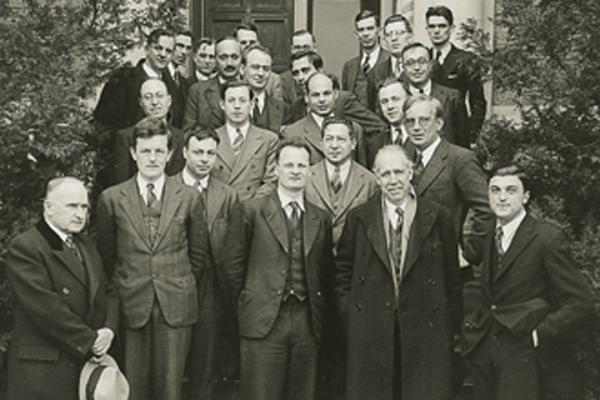
- A hot phase rich in photons with
a relatively small amount of
mass-energy
in the form of matter.
- A log-log plot
cosmic temperature
versus cosmic time
from the
quark era (cosmic time t∼ 10**(-12) -- 10**(-6) s)
to the
recombination era t = 377,770(3200) Jyr.
Time zero is the
Big Bang singularity which probably
did NOT happen.
Our best theory is that
the inflation era (10**(-36) -- 10**(-32) s)
happened in the
very early universe
(t < 10**(-12) s)
and then the universe tracked into
a standard
Friedmann-equation model thereafter.
- Big Bang
nucleosynthesis era
(cosmic time ∼ 10--1200 s ≅ 0.17--20 m):
- By the 1960s, it
became clear that only the
observable universe's
hydrogen (H),
helium (He) (mostly),
and some of its
lithium (Li)
were synthesized in the
Big Bang
nucleosynthesis era
(cosmic time ∼ 10--1200 s ≅ 0.17--20 m).
They is unbelievable, but so is the universe.
- All other elements
were synthesized in
stars
and supernovae---except for
trace amounts of some rare
isotopes which are synthesized
in rare processes.

- By the 1960s, it
became clear that only the
observable universe's
hydrogen (H),
helium (He) (mostly),
and some of its
lithium (Li)
were synthesized in the
Big Bang
nucleosynthesis era
(cosmic time ∼ 10--1200 s ≅ 0.17--20 m).
- The
cosmic composition
results from the
Big Bang and then
stars
and supernovae.
- The nearly perfect
blackbody spectrum of the
cosmic microwave background (CMB)
from the
Cosmic Background Explorer (COBE, 1989--1993).
The cosmic microwave background (CMB) is one of the strongest proofs of the Big Bang theory: there is NO other plausible explanation for cosmic microwave background (CMB) given all the other constraints of the observable universe.
The cosmic microwave background (CMB) was discovered fortuitously in 1965 by Arno Penzias (1933--) and Robert Wilson (1936--).
- From 1930s
to the 1990s
various cosmological models had vogues including
the Lemaitre universe
(in the period before circa 1965 but without
primeval atom)
and
Einstein-de Sitter universe (1932,
standard model of cosmology c.1960s--c.1990s).
- From the circa 1995,
the vogue model has been
the Λ-CDM model:
the current standard model of cosmology (SMC, Λ-CDM model),
but it is now under attack from tensions.
- The Lambda-CDM model
cosmic scale factor a(t),
the cosmic temperature,
and the approximation
ionization until the
recombination era,
z=1089.90(23), t=377,700(3200) years).
- Words for our ignorance
dark matter
(the cold dark matter or CDM)
and dark energy
(the alternative to the
cosmological constant Λ).
- Dark matter is ∼ 6 more abundant
than ordinary matter
baryonic matter.
- The dark matter
clumped in the early observable universe
to form
dark matter halos in which the
galaxies formed.
The baryonic matter
was clumped by the gravitational force
of the dark matter
- The amount of dark matter
in galaxies is ⪆ 30 times more than
the baryonic matter as
we know from galaxy rotation curves.
- What is the dark matter?
The standard idea is that is an exotic particle that is highly non-interacting
with itself and other
matter, except through
gravity.
The exotic particle forms a pressureless gas.
- So far the dark matter has NOT
been observed directly.
Its exitence has been inferred from its
gravitational effect.
- There are endless theories
about what the exotic particle is and there
are very advanced searches for it---that have had NO luck so far.

- Since circa 1998,
we know that the
universal expansion
has been accelerating, NOT decelerating as in the
Einstein-de Sitter universe.
- The easiest theoretical solution has
been the cosmological constant Λ
adjusted to give acceleration rather than
a static Friedmann-equation (FE) model.
Hence the &Lambda in the
term Λ-CDM model.
- However,
cosmological constant Λ
can be replaced by a (constant)
dark energy which
has the same cosmological effect as
the cosmological constant Λ,
but differs in other respects.
- Now particle physicists
favor dark energy for
darn good particle physics reasons---but
they can't tell us what it should be exactly.
- In fact,
cosmologists tend to
just conflate
cosmological constant Λ
and dark energy as
Λ when
they are just specifying the cosmological effect.
- But what is dark energy
and does it have to be constant?
There is NO end of theories,
but which if any is right we do NOT know.

- Dark matter is ∼ 6 more abundant
than ordinary matter
baryonic matter.
- The Hubble tension:
- Direct measurements H_0 = 73(2) (km/s)/Mpc (fiducial values).
- The indirect measurements based on fits of the Λ-CDM model to observations give H_0 = 67.36(54) (Planck 2018, p. 14).
- So >∼ 3 sigma discrepancy.
- Uddin et al. 2023 find the tension is less than 3 sigma form local direct measurements, and so there is still an argument about the tension.
- Are the tensions going to cause us to change to a new
standard model of cosmology (SMC)?
Very likely, but ...
It seems almost always case, you see one new paper saying how the Lambda-CDM model fails their test by 3 or 4 sigma and then the next new paper says how the Lambda-CDM model is consistent with their test.
Obviously, the Lambda-CDM model is just a very good description of the observable universe to within a few percent loosely speaking.
Finding a new cosmological model that fits everything to within tenths of a percent and maybe is fundamentally true is a challenge.
What are the possible new cosmological models?
They are quasi endless and all over the place.
Which if any of them are right is a hard question.
But more data (exabytes of it) is on the way.
More below on more data.
- Inflation cosmology describes
what came before the Big Bang:
i.e., before the
Big Bang era (post-inflation to cosmic time to ∼ 20 m).
The inflaton.
- A cartoon of the
cosmic scale factor a(t) of
observable universe
including the
inflation era
(cosmic time ∼ 10**(-36)--10**(-33) or 10**(-32) s).
- The horizon problem illustrated.
The diagram
is not-to-scale.
- The
Cosmic microwave background
(CMB) power spectrum as determined by several
experiments indicated on the
graph.
- A cartoon of
eternal inflation
which is both a
version of inflation
and a
version of the multiverse:
a universe made up of some kind of
pocket universes.
One assumes general relativity applies to the whole multiverse, and so maybe the multiverse is in overall expansion or contraction.
But is the gravitational constant G = 6.67430(15)*10**(-11) (MKS units) the same throughout the multiverse?
-
The new spacecraft missions of the
2020s and
2030s will
map out the
cosmic scale factor a(t)
to better accuracy than now---hopefully much better.
- Euclid (c.2021--c.2027)
videos:
- Euclid in a nutshell (2023) | 1:14: The Euclid spacecraft (2023--2029?) and its space mission. Good for the classroom.
- The Euclid Space Telescope: tackling dark matter and dark energy mysteries (2023) | 14:54: A good explication of the Euclid spacecraft (2023--2029?) and its space mission. Too long for the classroom.
- James Webb Space Telescope
(JWST, 2021--2041?)
videos:
- The Emergence of Galactic Structure in the JWST Era CfA Colloquium with Erica Nelson, 2023mar28 | 1:07:00: Probably, good on implications for large scale structure of the observable universe. The new stuff starts at 22:00. Too long for the classroom.
- 2023 William H. Pickering Lecture: Discoveries with the James Webb Space Telescope, 2023jan25 | 1:02:56: "William H. Pickering Lecture: Discoveries with the James Webb Space Telescope, featuring remarks by Jonathan Gardner, deputy senior project scientist, James Webb Space Telescope, NASA Goddard Space Flight Center, at the AIAA SciTech Forum in National Harbor, MD, January 25, 2023." Too long for the classroom.
- Roman Space Telescope
(RST, c.2025--c.2030, formerly WFIRST)
videos:
- NASA's Nancy Grace Roman Space Telescope: Broadening Our Cosmic Horizons | 2:19: From NASA: Nancy Grace Roman Space Telescope. Good for the classroom.
- Simulated Image Demonstrates the Power of NASA's Nancy Grace Roman Space Telescope | 2:42: From NASA: Nancy Grace Roman Space Telescope. Too detailed for the classroom.
- Nancy Grace Roman and the Roman Space Telescope, 2023jun28 | 1:34:59: On both Nancy Roman (1925--2018) and the mission of her eponymous Roman Space Telescope (RST, c.2025--c.2030, formerly WFIRST). Far too long for the classroom.
They should also put much tighter constraints on structure formation (AKA large-scale structure formation).
Exabytes of new data will become available.
Alas, all the information will have to be pulled out of the data by statistics.
Ernest Rutherford (1871--1937) once said if you need statistics, you are doing the wrong experiment.
To gloss his aphorism, you should do the decisive experiment.
The information from statistics is all we have it seems.
The new spacecraft missions:
-
To conclude:
- We are in the golden age of cosmology (c.1992--).
- The cosmic scale factor a(t) will certainly be mapped out better by Euclid (c.2021--c.2027) and the Roman Space Telescope (RST, c.2025--c.2030, formerly WFIRST) by circa 2030.
- But will cosmology and particle physics solve all their combined mysteries? Maybe soon, maybe never.
- In any case, it is amazing that from our small platform
Earth, we can contemplate
eternity
and infinity.

